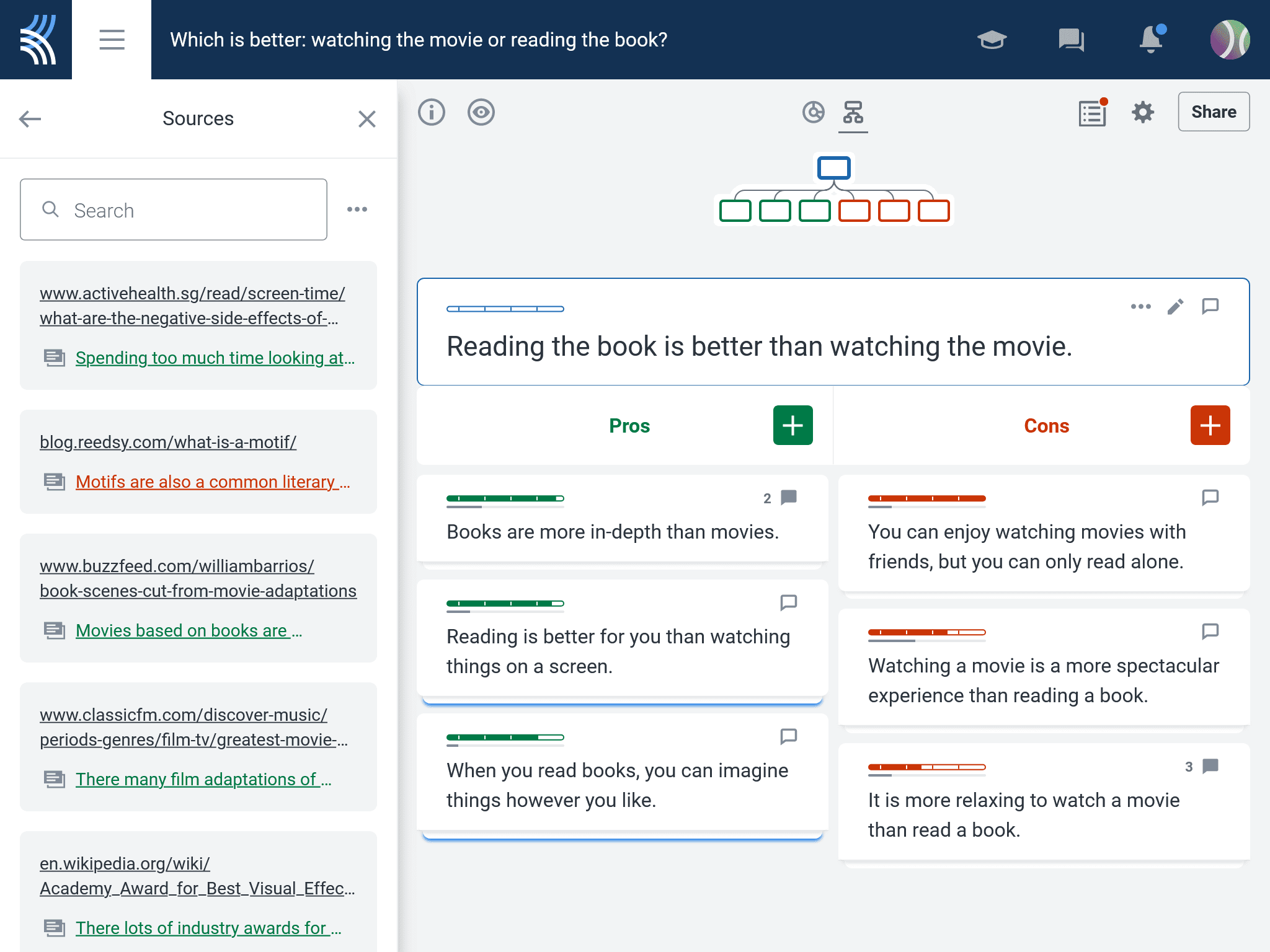Kialo Edu’s completely free innovative discussion platform helps students build and understand sophisticated lines of reasoning. Its engaging visual format is based on argument mapping principles, making it ideal for teaching students how to analyze and evaluate arguments!
Let’s explore how to analyze and evaluate arguments and how activities on Kialo can help students master these crucial academic skills.
What’s the difference between analyzing and evaluating arguments?
Many view an argument as a conflict of opinions. However, academic arguments are actually structured discussions built on premises, conclusions, and objective evidence. Analyzing and evaluating these arguments helps students develop critical thinking skills that benefit them across all subjects. But how do analyzing and evaluating differ?
Analyzing an argument
Analyzing an argument involves conducting a thorough examination of its structure and clarity. Students take an objective approach by breaking down the argument into its essential components — premises and conclusions. Then, they use logic to analyze whether the premises support the conclusion.
Evaluating an argument
Evaluating an argument involves making a comprehensive assessment of its overall strength and persuasiveness. Students subjectively judge the argument’s validity and soundness, as well as the relevance and credibility of the evidence presented.
Five activities for analyzing and evaluating arguments
Students can use Kialo’s interactive discussion map to create and view arguments constructed from claims and counterclaims. This visual representation provides an ideal framework to analyze and evaluate arguments.
Students could use the discussion map to:
- Deconstruct and analyze an existing argumentative essay.
- Assess and evaluate an overall discussion.
- Construct their own arguments for peers to analyze and evaluate.
- Analyze and evaluate a ready-made Kialo discussion, such as Should social media websites remove posts which spread misinformation? or What is the best way to fight climate change?
Whichever Kialo activity you choose, use these questions to guide your students through the analysis and evaluation process.
1. Do the premises support the thesis?
An effective argument centers on a clear thesis. On Kialo, the thesis is prominently displayed at the top of the discussion, allowing students to quickly grasp the main point. They should analyze the thesis for originality, clarity, and conciseness, ensuring it has a narrow enough scope to be arguable.

Beneath the thesis, the argument is deconstructed into pro and con claims, representing the premises. Each one should focus on a single point that directly responds to the claim above. This clear layout allows students to more easily determine whether claims effectively support or challenge the thesis.
2. Is the argument well-structured?
On Kialo, students can organize the different aspects of an argument into separate branches that represent different lines of reasoning. Students can quickly analyze whether each branch effectively addresses a specific facet of the argument or if there is any overlap.
By organizing arguments into branches, students can better see the hierarchy of reasoning for claims, with connective lines clearly illustrating its logical relationships. This structure helps students analyze connections between claims and identify when points don’t logically follow.
3. Are the premises well-supported?
The best arguments are supported by sound evidence. On Kialo, sources and references can be linked directly to individual claims. All sources are then conveniently stored in the Sources sidebar, organized alphabetically for ease of reference. This makes it easier for students to establish whether a discussion’s arguments include a sufficient range of evidence.

Furthermore, students can evaluate sources for reliability and credibility, using strategies such as lateral reading. Plus, the sidebar allows students to view the claim and source together to assess whether the source effectively supports the claim.
4. Are counterarguments addressed?
The strongest arguments effectively address counterarguments. Kialo simplifies this process by presenting counterarguments as color-coded cons, allowing students to verify that the argument includes all relevant counterarguments.
Additionally, the discussion mini-map gives students a quick visual indicator of the balance between supporting arguments and counterarguments. By clicking through the branches, students can analyze whether all counterarguments are rebutted effectively.

5. How effective is the argument overall?
Following the steps above should give students the necessary insights to evaluate the overall effectiveness of the argument. To aid their evaluations, students can make notes as Comments during their analysis or vote on individual claims, allowing them to quickly gauge the impact of each point.
Then, students can evaluate the argument’s overall strengths and weaknesses, considering the argument in the context of their broader reading and existing knowledge before reaching their final conclusion on its effectiveness.
We hope you try out these strategies using Kialo’s completely free discussion platform to teach students how to analyze and evaluate arguments.
We’d love to hear how your students are benefiting from their Kialo discussions! Contact us at feedback@kialo-edu.com or on social media.

